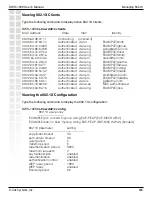
348
DWS-1008 User’s Manual
D-Link Systems, Inc.
Rogue Detection and Countermeasures
Dynamic Frequency Selection (DFS)
Some regulatory domains require conformance to ETSI document EN 301 893. Section 4.6
of that document specifies requirements for Dynamic Frequency Selection (DFS). These
requirements apply to radios operating in the 5 GHz band (802.11a radios).
In countries where Dynamic Frequency Selection (DFS) is required, MSS performs the
appropriate check for radar. If radar is detected on a channel, the AP radio stops performing
active scans on that channel in accordance with DFS. However, the radio continues to
passively scan for beacons from rogue devices.
When an AP radio detects radar on a channel, the radio switches to another channel and
does not attempt to use the channel where the radar was detected for 30 minutes. MSS also
generates a message.
Note:
The RF Auto-tuning feature must be enabled. Otherwise MSS cannot change the
channel.
Countermeasures
You can enable MSS to use countermeasures against rogues. Countermeasures consist of
packets that interfere with a client’s ability to use the rogue.
Countermeasures are disabled by default. You can enable them on an individual radio-profile
basis. When you enable them, all devices of interest that are not in the known devices list
become viable targets for countermeasures.
Summary of Rogue Detection Features
Rogue Detection Features lists the rogue detection features in MSS.
Rogue Detection Features
Rogue
Detection
Feature
Description
Applies To
Third-
Party APs
Classification MSS can classify third-party APs
as rogues or interfering devices.
A rogue is a third-party AP whose
MAC address MSS knows from
the wired side of the network. An
interfering device does not have a
MAC address known on the wired
side.
MSS can detect rogue clients,
locate their APs, and issue
countermeasures against the APs.
Yes
Yes
















































